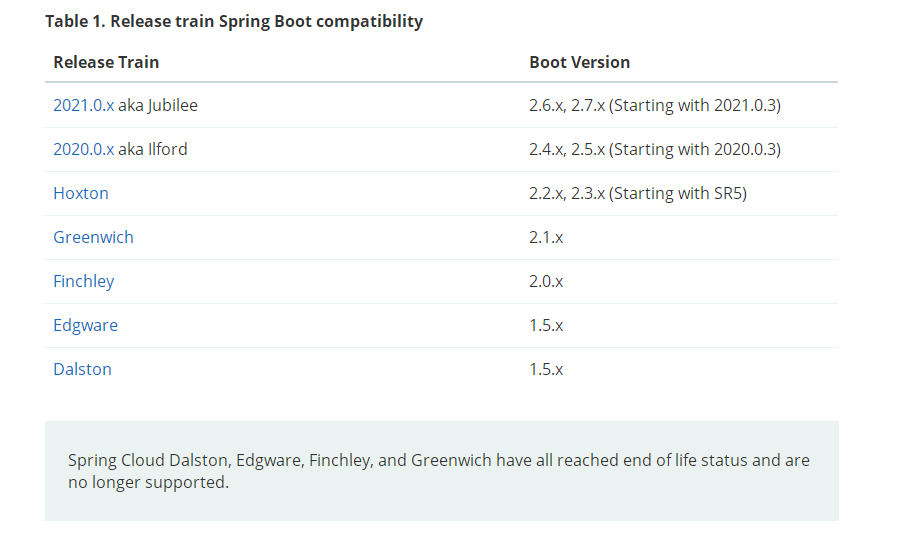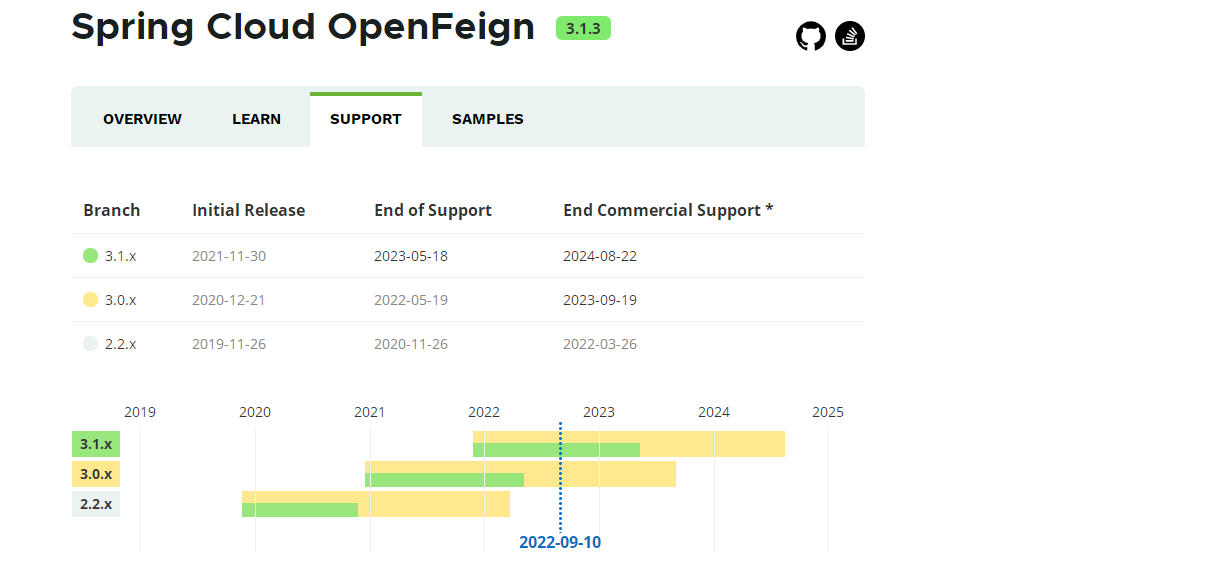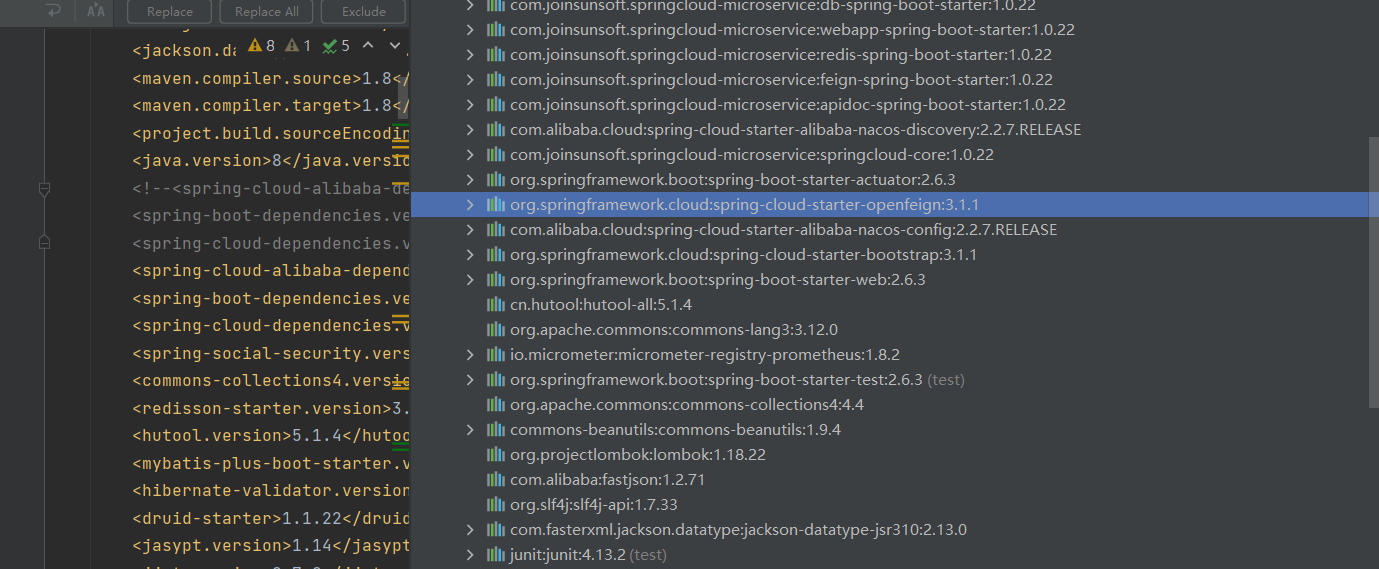前言
Springcloud解决方案,实现微服务;是目前很多中小公司实现微服务的常见的解决方式;在每个微服务单元之间的RPC调用,在SpringCloud的解决方案中通过Web Restful实现也是最常见的场景,在Springcloud的整体解决方案中,官方推荐的是使用SpringCloud OpenFeign来实现此目的;有关这个话题很多技术论坛都有相关的文章进行介绍,在大多数的文章中,还没有与时俱进,SpringCloud的版本还停留在2019年推出的以地铁站为命名的一系列版本里,例如Hoxton.SRX等;2019版本已经过于旧了,其中的netifix的ribbon和hystrix都已经不进行维护了,今天咱们要给大家介绍的就是使用最新的SpringCloud2021系列的版本进行OpenFeign的集成,从而实现RPC。
SpringCloud&SpringBoot

以上的图是SpringCloud官网上的SpringCloud的release Map图; 最新的SpringCloud的版本是2021.0.X, 注意第二列,由于SpringCloud是基于SpingBoot框架而进行实现和定义接口的,所以需要严格的对应SpringCloud和SpringBoot的版本; 如上图所示, 我们的SpringBoot可以选择使用2.6.X系列或者2.7.X系列, 笔者建议先使用2.6.X系列

SpringCloud OpenFeign

上图是从SpringCloud官网的OpenFeign模块的主页摘录下来的; (https://spring.io/projects/spring-cloud-openfeign)
如图中说示: OpenFeign是声明性REST客户端:Feign创建一个用JAX-RS或Spring MVC注释装饰的接口的动态实现REST RPC的实现。
下图是SpringCloud OpenFeign的版本蓝图, 笔者建议使用3.1.X版本,笔者自己使用的是3.1.1版本

SpringCloud OpenFeign工作流程

Target(动态代理层),即为我们通过FeignClient实现RPC定义的接口层,此次技术使用了Java的动态代理技术和SpringBoot里的BeanProcessor的Bean生命周期管理的技术;
Constract为合约层,在SpringCloud的WebMvc实现了WebMvcContract,为默认的合约,没有指定合约时即使用该合约; OpenFeign包里实现了Feign的标准合约,通常我们的项目开发里都是没有特别指定的,都是用的Mvc的合约,在FeignClient的RPC接口定义时,使用的annotation也都是MVC的annotation, 如:PostMapping, GetMapping
MethondHandler是动态代理的具体实现方法,对应的就是去Target进行RPC的调用
使用步骤
引入OpenFeign包
<dependency>
<groupId>org.springframework.cloud</groupId>
<artifactId>spring-cloud-starter-openfeign</artifactId>
</dependency>
<dependency>
<groupId>org.springframework.cloud</groupId>
<artifactId>spring-cloud-starter-loadbalancer</artifactId>
</dependency>
<dependency>
<groupId>org.springframework.cloud</groupId>
<artifactId>spring-cloud-loadbalancer</artifactId>
</dependency>
<dependency>
<groupId>org.springframework.cloud</groupId>
<artifactId>spring-cloud-starter-circuitbreaker-resilience4j</artifactId>
</dependency>
<dependency>
<groupId>io.github.resilience4j</groupId>
<artifactId>resilience4j-feign</artifactId>
<version>1.7.0</version>
</dependency>
启动类引入Feign支持
@SpringBootApplication
@EnableFeignClients
public class Application {
public static void main(String[] args) {
SpringApplication.run(Application.class, args);
}
}在启动类里需要增加@EnableFeignClients注解,这样项目启动是,会有autoconfiguration机制自动的在Application为根包路径下去扫描所有的FeignClient,并产出流程步骤中所表示的动态代理层的Bean对象;
定义客户端RPC接口
在客户端定义接口,去调用服务提供方提供的WEB RESTFUL的服务;
客户端只需要根据服务提供方提供的WEB API的标准,定义出访问的API,通过对客户端的接口访问,就会处理到动态代理层,动态代理层根据合约对接口进行WEB RESTFUL的封装,然后在methodHandler里通过HttpClient的方式去服务提供方进行WEB调用,从而完成RPC的实现;
@FeignClient("stores")
public interface StoreClient {
@RequestMapping(method = RequestMethod.GET, value = "/stores")
List<Store> getStores();
@RequestMapping(method = RequestMethod.GET, value = "/stores")
Page<Store> getStores(Pageable pageable);
@RequestMapping(method = RequestMethod.POST, value = "/stores/{storeId}", consumes = "application/json")
Store update(@PathVariable("storeId") Long storeId, Store store);
@RequestMapping(method = RequestMethod.DELETE, value = "/stores/{storeId:\\d+}")
void delete(@PathVariable Long storeId);
}上面这些都是使用的MVC的合约,使用的annotation都是MVC的annotation; 下面的例子是使用Feign自己的标准annotation; 笔者建议使用这种方式更为标准
// after Hystrix is removed from SpringCloud2021.0.1, the fallback is ineffective
@FeignClient(name = "${codeman.service.name:codeman}", url = "${codeman.service.address:}", fallback = CodeManFallbackImpl.class)
public interface CodeManFeign extends CodeManService {
@RequestLine("GET /codeman/info/version")
public String getVersion();
@RequestLine("GET /codeman/info/author")
public String getAuthor();
@RequestLine("GET /codeman/info/request/{userid}") //对应请求方式和路径
public String requestLine(@Param("userid") String userid);
}调用RPC
@Slf4j
@Component("CodeManService")
public class CodeManServiceImpl implements CodeManService {
@Autowired
CodeManFeign codeManFeign;
@Override
@CircuitBreaker(name = "default", fallbackMethod = "getVersionFallback")
public String getVersion() {
return codeManFeign.getVersion();
}
@Override
@CircuitBreaker(name = "default", fallbackMethod = "getAuthorFallback")
public String getAuthor() {
return codeManFeign.getAuthor();
}
@Override
@CircuitBreaker(name = "default", fallbackMethod = "requestLineFallback")
public String requestLine(String userid) {
return codeManFeign.requestLine(userid);
}
public String getVersionFallback(Throwable t) {
log.info("================================= Exception(getVersion): {}", t.getMessage());
return "N/A";
}
public String getAuthorFallback(Throwable t) {
log.info("================================= Exception(getAuthor): {}", t.getMessage());
return "SpringCloud";
}
public String requestLineFallback(String userid, Throwable t){
log.info("================================= Exception(requestLine): {}", t.getMessage());
return "Kill team‘s poison " + userid;
}
}
结束语
本文主要介绍的是在springcloud最新版本里使用OpenFeign实现RPC调用,作为完整的OpenFeign的RPC调用实现,还有更高级的一些话题,比如Fallback; LoadBalance; 和服务发现集成使用等高级用法,本文篇幅有限,在以后的相关文章会介绍这些OpenFeign使用的高级用法;敬请大家持续关注;
谢谢大家持续关注,不要错过精彩内容。